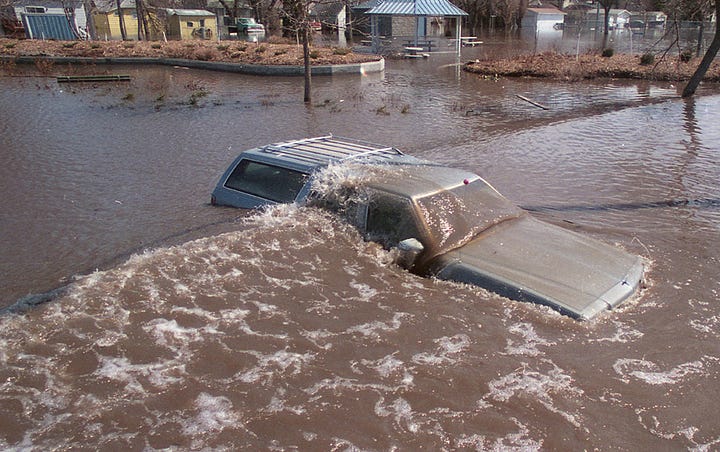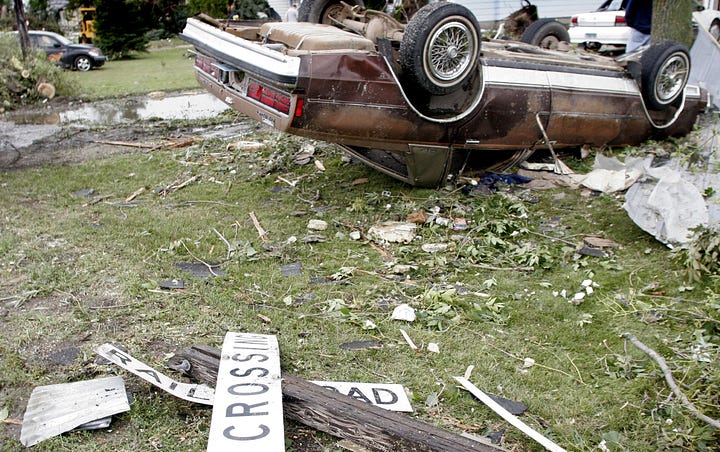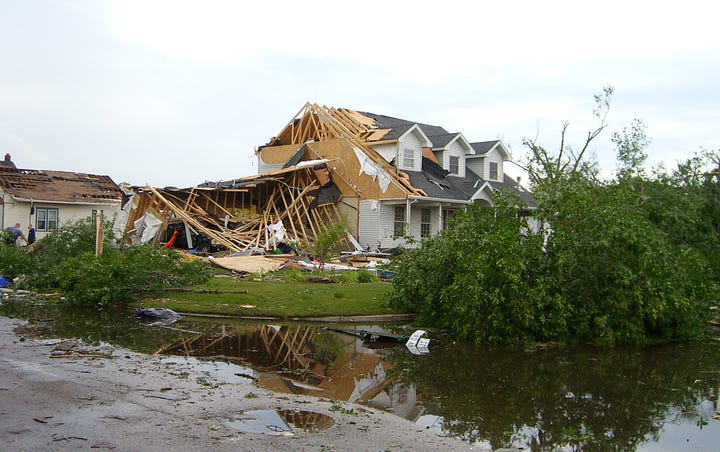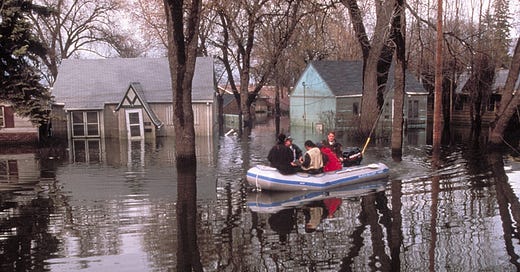Astronomical federal deficits, concentrated, usurious giga banks, and limited productive vision mark the present and future our nation is creating. The state-owned public Bank of North Dakota (BND) presents an alternative: 105 years of proof of concept of popular vision, political will, commercial competence, and productive public credit for the individual and public prosperity.
I have lived in neighboring Minnesota from childhood and have noticed significant differences in the economies and infrastructure of the two states. As an adult, I moved to Duluth and served as a law clerk for judges in northeast Minnesota. Work took me up Interstate 94, which connects the Twin Cities to Moorhead and then Fargo, North Dakota. Fargo and Moorhead are across the Red River of the North from each other. After the Red River flood of 1997, and again 2009, Fargo rebuilt faster than Moorhead. “Why?” I asked.
The 1997 Red River flood devastated Grand Forks, North Dakota and East Grand Forks, Minnesota. The BND swung into action to rebuild the city. Three years later, the population of Grand Forks had only dropped 3%. East Grand Forks suffered a 17% population decline. BND supported the state through the rise of the oil industry, and kept the state on a steady keel when oil crashed in 2014. This was in stark contrast to Minnesota’s Iron Range Resources and Rehabilitation Board (IRRRB), which has not stabilized the Iron Range economy as the BND has done for North Dakota.




"An extremely harsh winter coupled with 1997 flooding in North Dakota’s Red River Valley was the first time since the Great Depression that BND provided disaster relief support. Ranchers repopulated their cattle herds, businesses re-opened and homes were rebuilt with BND's assistance. BND answered the call again in 2005, 2007, 2009, 2011 and 2018 when weather-related events including a tornado and more flooding had significant impacts on the lives of North Dakotans. These loan programs are always done in partnership with local lenders." Photos courtesy BND. Source.
On paper, IRRRB invests a portion of the wealth from iron mining back into northeastern Minnesota. That sounds similar to the Bank of North Dakota. Both use public resources to advance the public good. But are they really similar? No, they are not – not by a long shot.
A major difference is their source of funds. The IRRRB uses a public resource, namely a tax of $2.56 on every gross ton1 of the iron-bearing minerals taconite and iron sulphide mined in northern Minnesota. It has no other source of funds. The IRRRB does not remit funds to the State Treasury, and it is NOT a depository bank.
Republican Governor Harold Stassen and the Republican Minnesota Legislature created the IRRRB in 1941, responding to the 1938 unionization of Iron Range miners. The IRRRB defines itself as:
[A]n economic development agency that reinvests local taconite production taxes back into northeastern Minnesota businesses and communities in order to strengthen and diversify the economy. Loans are provided to businesses relocating or expanding in the region. Grants are available to local and tribal units of government, educational institutions, and nonprofits. Grants support projects related to business development, infrastructure and broadband, downtown revitalization, worker training and certification, and tourism and recreation.
State law limits IRRRB to its boundaries in northeastern Minnesota. The boundaries exclude Duluth, Minnesota’s fifth largest city and the United States’ most inland international seaport.
The IRRRB has had limited success as measured by the industry, people, and prosperity of northeastern Minnesota, which has lost population since 1970. The iron industry sustained production and employment losses beginning in 1978 from which the Iron Range has not recovered. The IRRRB presents no alternative vision of productivity to the dominant view of the mining companies. IRRRB created no new industries to employ miners and sustain families who suffered years of mine closures and payroll shrinkage.
The BND, by contrast, is a licensed depository bank founded in 1919 after years of painstaking, bare-knuckle, grassroots political organizing by the Nonpartisan League (NPL), and electoral victories by the NPL in 1918 to seat an NPL legislature and governor. In the late 1950’s, the NPL took hold in the North Dakota Democratic Party as Quentin Burdick, the son of Republican NPL stalwart Usher Burdick, won election to the U.S. Senate. Currently, the BND enjoys support of North Dakota’s Democratic-NPL and Republican parties, with U.S. Senator John Hoeven (R-ND), a former Governor and CEO of BND, as a prominent ally.
The state is mandated by law to deposit into BND state taxes and fees and those collected by every political subdivision in North Dakota, with only a “very small” portion of its deposits coming from North Dakota residents.
“Most of BND’s deposits come from the state’s collection of taxes and fees. The balance of the Bank’s deposits come from corporate accounts, North Dakota city and county government entities, and North Dakota financial institutions.”
BND backstops private lending without directly competing with private local lenders, having only one office in Bismarck and an outpost in Fargo. This participation lending gives BND a continual source of revenue from the interest collected. BND has a seven-member advisory board of individuals “knowledgeable in banking and finance,” and a seven-member, similarly talented Executive Board.
Unlike the IRRRB, the BND serves the entire state of North Dakota. IRRRB is a state agency, NOT a depository bank, and finds its niche as a “pass-through” department that serves only a limited state constituency.
BND issued the first student loan in the nation in 1967, and it has engendered the largest per capita network of community banks in any state of the Union. BND kept North Dakota in the black through the crisis of 2007-2009, remitting interest from its loans into the North Dakota Treasury.
For 105 years, BND has served the state of North Dakota by sound marshaling of public credit in support of, and in harmony with, private credit. BND is no Marxist money-changing monolith, nor is it a political patronage fountain. BND survived the Great Depression, the Crisis of 2007-2009, and the rise and decline of North Dakota’s oil industry. BND kept North Dakota farmers on their farmland, and corporations off them. BND kept North Dakota in the black while other states, including Minnesota, resorted to legerdemain to balance their books and plug deficits in the 2000’s and 2010’s.
The BND works for North Dakota. With the full faith and credit of the people behind it, and accountable public servants with a head for banking, a public bank can work anywhere.
Respectfully,
Peter J. Nickitas
Minn. Stat. §298.24




